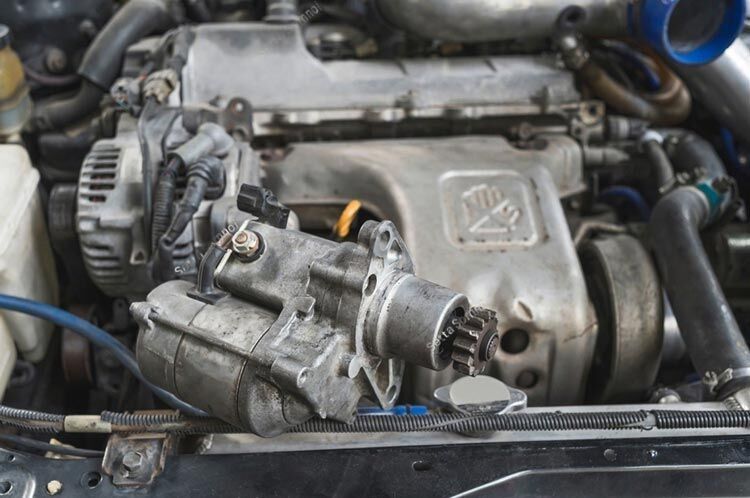After a period of time, having to fix your vehicle engine and other components is unavoidable. One of the most common problems you might face is starter issues.
If you have a defective starter and want to replace a new one, knowing its location is a prerequisite. So where is the starter located in a car?
You might be curious about the location of an entire starter. Sem problemas!
This article will discuss this interesting question thoroughly and show more facts about starters. Now lets check it out.
What Is A Starter?

The starter system components include a starting motor, a solenoid, a gear, and a housing, powered by a 12-volt battery.
Because the internal combustion system cannot start by itself, there should be cars using internal combustion engines that are often equipped with an additional starting system.
On an internal combustion engine, the starting system spinning will transmit a torque to the engines crankshaft with a specific number of revolutions to start the engine.
For cars with an auto transmission, only when the car is shifted to N or Park gear can the starter motor work.
On the other hand, you need to press the clutch pedal if you are driving a car with a manual transmission.
Now, where is a starter in a car ?
Where Is The Starter Located In A Car?
.Not all vehicles starters are placed in the same position. Depending on the vehicle structure, you can find the starter either on the driver or passenger side.
For rear wheel drive (RWD), your cars starter is positioned on the passenger side, near the transmission on the bottom of the engine.
But for front wheel drive (FWD), the starter is on the drivers side of the engine, underneath the cylinders left bank.
There are some bolts that secure and affix it to the mounting plate. Also, you can find two wires that are connected to the starter.
How To Find Car Starter Location?
It contains several cables that link to other cars electrical components and is located near the cylinders edge.
The starter will stand out with its cylindrical shape. It is made up of two cylinders that do not have equal size, one wider than the other.
You should remember that one of them is the solenoid, whereas the remaining one is the starter.
Where Is the Starter Located on Various Vehicle Models?
The negative terminal wire is affixed to the starter motor. Its a cylinder 6 inches long, connected to the spinning wheel.
You might need to use a flashlight and automobile jacks. Raising the cars front end provides access to the engines underbelly, where the starter is situated.
Where Is The Starter Located On A Chrysler Cirrus?
Em relação a um cirro do motor de 2,4-l, o iniciador está localizado abaixo do módulo de controle de transmissão (TCM) , que é uma caixa na parte traseira do seu motor.
To replace the starter, you must unscrew the TCM and detach the air intake system. The starter is connected to the transaxle by an extra bolt that must be reached from below the car.
With a 2.5-L engine Cirrus, you can easily spot the starter in the vicinity of the oil filter, and it should be accessible from beneath the car.
It is bolted to the transaxle in three places. To replace it, you must first detach the filter and untighten the bolts that connect the manifold and exhaust pipe.
The battery positive terminal is secured in place for both versions using a screw. There is a cable attached to the solenoid through a push-on connection.
Before uninstalling the starter, these should be unplugged. Its important to detach the negative terminal for safety precautions.
What Causes A Defective Starter?
A sign of a relay not working properly is that you will hear a constant clicking sound when pressing the button.
O motivo é que a fonte de alimentação das bobinas de sucção é instável ao passar pelo relé, causando sucção e liberação contínuas.
Isso pode levar ao deslizamento de rosca e quebra de engrenagem, prejudicando a qualidade do fio.
Corrosão da bateria
As conexões da saída da bateria e da entrada de partida são propensas a corrosão e ferrugem devido à oxidação, causando um contato ruim.
A corrente fornecida ao acionador não é suficiente para gerar um torque grande para aumentar o motor.
A maioria dos grampos ou parafusos que capturam esses conectores não são de cobre ou alumínio, então eles rapidamente ficam danificados e enferrujados, deteriorando a qualidade da corrente de partida.
Essas juntas devem ser verificadas e limpas regularmente para garantir um bom contato.
Sem mencionar, uma bateria corroída pode levar a outros perigos .
Sintomas de um motor de partida ruim
Portanto, procurar a ajuda de uma instalação de reparo de automóveis o ajudará a determinar e corrigir o problema.
Som de moagem
Se as engrenagens no pinhão estiverem quebradas, você poderá ouvir um ruído de moagem ao ligar a tecla de ignição.
Depois que os componentes iniciais se desgastam ou não se envolvem corretamente, um ruído de moagem é produzido, semelhante ao ruído após o motor desligado .
Fumaça
Etapa 4: Remova os parafusos e depois o iniciante
A maioria dos iniciantes é mantida firmemente por dois ou mais nozes hexadecimais. Primeiro, desaparafuse os parafusos com o soquete de um tamanho adequado para instalar o motor de partida.
Se você não usar o tamanho do soquete certo, causará parafusos quebrados.
Depois que os parafusos forem liberados, pode ser necessário puxar o motor de partida com alguma força para separá -lo do motor.
Etapa 5: deslize o novo iniciante no lugar
Substitua o iniciante fresco no ponto de montagem exato como o anterior. Você precisa acessar o motor acima ou abaixo, dependendo do design do seu carro.
Para posicioná -lo corretamente, pode ser necessário arrastar o novo acionador para baixo e em torno de outras peças.
Etapa 6: Insira os parafusos iniciais
Freque cada parafuso girando manualmente no sentido horário para apertar o motor de partida. Em seguida, usando um soquete e chave adequados, aperte -os.
Se algum parafuso permanecer solto, solte -os e tente novamente. Isso impede que o parafuso oscilante e o jogo livre quando o carro está em movimento.
Etapa 7: Conecte a fiação
Conecte o fio (que você desconectou do antigo) aos terminais do novo motor de partida assim que o motor de partida do automóvel estiver no lugar.
Se não tiver certeza, consulte o manual e faça as conexões de fiação adequadas.
Etapa 8: Reconecte a bateria
A etapa final é reconectar a bateria. Ligue o fio preto ao terminal da bateria negativa.
Em seguida, digite a chave na ignição e tente iniciar seu veículo. Você sabe que sua substituição inicial é um sucesso quando o motor aumenta sem problemas.
Conclusão
Onde está o motor de partida em um carro? Depois de ler este post, esperamos que você possa encontrar a resposta para esta pergunta.
Um titular desempenha um papel vital na operação do carro. No entanto, o iniciador original pode ficar ruim por muitos motivos, como cabos de bateria com defeito, relé com defeito ou fusível com defeito.
Portanto, conhecer a localização do motor de partida pode ajudá -lo a substituir um novo em sua casa sem entrar em contato com nenhum mecânico experiente.
Felizmente, com as informações acima, você obteve mais conhecimento e experiência mais úteis na indústria automobilística.
Lembre -se de reparar seu problema inicial assim que descobrir os sintomas.
